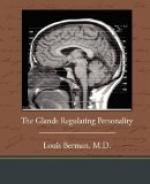To reconstruct the endocrine formula or equation of Nietzsche inductively, one should analyze first the information available concerning his parents and relatives. His grandfather was a conservative bourgeois of a superior type, who was the author of treatises designed to narcotize the forces of rebellion of his time. What he was like physically, no epitaph declares. His father was a clergyman. A description of him reads ... “tall and slender, with a noble and poetic personality, and a peculiar talent for music ... short-sighted.” That ranks him at once as a pituito-centric. The mother was dark and had a fiery temper and came of a family distinguished for the powerfully built anatomy of its members. In the heredity of Nietzsche, the father appears therefore to supply a pituitary predominating element, the mother an adrenal-pituitary predominating element.
Nietzsche himself worked strenuously at the intellectual life (after 20, when he probably stopped growing, and the brain tonic action of the ante-pituitary could manifest itself). Early distinction rewarded him with a professorship in philology at 24. One of Prussia’s wars of conquest entangled him, and presented him with diphtheria. A friendship with Richard Wagner marked the turning point of his life, and the point of departure for his works on the most fundamental values of human life. Meanwhile, attacks of sick-headache of varying degrees of severity made him miserable periodically—they came about every two weeks and lasted two to three days—and left him wretched and exhausted. At last, at 44, a species of stroke terminated his sufferings, causing him to lose his speech and memory, and thenceforth there was progressive deterioration, physical and spiritual, with repeated attacks.
In the sister’s biography there are several good photographs and reproductions of sculptures of Nietzsche at different ages. An examination of the frontispiece picture, which shows him in profile (profile views are the best for physiognomy), as well as of the bust of Nietzsche by Donndorf, exhibit the most striking traits of the head. To the student of internal secretions, the most prominent feature of the face, emphasized by both the camera and the artist, is the remarkable prominence of the supra-orbital arches, the bony protuberances from which the eyebrows spring. This is a definite pituitary character. The eyebrows themselves are luxurious and slope to meet, the bony development of the face as a whole is sharp and clean-cut, the skull tends to be long and narrow and the chin is square. All these point to a pituitary-centered personality. It is to be regretted that we have no picture or record of Nietzsche caught smiling, which would have preserved the state of his teeth for us. At any rate, considered as checks to my interpretation, his physiognomy and physique, the nature of his genius and the attacks which finally ruined his life, all fit into the conception of him as one whose life centered, like Napoleon’s, around what was happening in his sella turcica.




